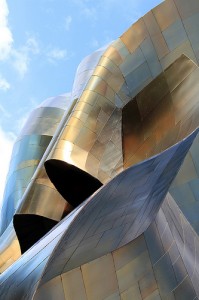
Towards the end of last year it seemed as if every geeky, gadgety, or photography website was featuring the awesome Glide 2, a slow-motion film shot from a high-speed train. In two weeks alone, it generated over 735,000 views. It was made by the lovely Graeme Taylor, and I was fortunate enough to be able to catch up with him over braised lamb shanks earlier this week, and heard about the similarities between maths and photography, finding a train suitable for filming, and devising a follow-up to Glide.
Daniela: You’re not actually a professional film-maker or photographer are you, Graeme? What do you do?
Graeme: No, and seeing myself labeled with descriptions such as ‘video artist’ has been entertaining! I’m a research mathematician, which I’d argue is a creative activity far closer to, say, photography, than the tedious grind of high-school calculations. Both maths and photography require a certain amount of technical ability, but beyond that, inspiration, experimentation, and the desire to ask lots of questions that start ‘what if…’ or ‘how could I…’ are crucial. It’s just that in my day job I’m trying to capture the behaviour of abstract concepts rather than a landscape or piece of architecture.
DEB: So do you envisage yourself making money from photos or films?
GT: I’m still rather pleased that I’m able to make money from mathematics! To be honest, I like the fact that my photo and video projects are purely hobbies, rather than having to be financially viable activities. Probably as a side effect of the way mathematics works (where you publish your results for all to build upon), I’m more interested in people seeing and enjoying my work than trying to maximise the amount of money I can extract from it. Of course, if anyone wants to sponsor future projects, that’s fine by me!
DEB: Where did the idea for a slow-motion film of a train coming into a station originate?
GT: The usual role of slow motion video is to capture a complicated, high speed activity from a static viewpoint. My first thought was, ‘What if the camera is the high speed object?’ I hoped that this would allow me to recreate the effect of panning through frozen motion which is common in films – the most obvious inspiration would be bullet time, of course. Somewhere along the line I came up with the other piece of the puzzle, which was to record something mundane rather than an action sequence. Then a station seemed like an obvious solution.
DEB: Did it take a great deal of preparation?
GT: My original plan was to record from a train that wasn’t stopping, so that I’d have constant speed through the station. I also knew I wanted a slam-door train so that I could film through an open window rather than glass. So the idea spent a lot of time on the back burner as I tried to think of a suitable journey – although I travel a lot by train, I couldn’t find a location that was busy enough to warrant filming, yet somehow unimportant enough for the train to blast through without stopping.
So I stopped trying to prepare and decided to wing it! Having decided to take my chances with stopping services, I took to travelling in the front carriage of trains (no great burden on London-bound journeys, as that meant booking first class) and always having the slow motion camera with me. As it happens, though, Glide was my very first capture of this type, and Glide 2 was taken the following weekend at the same station. So, perhaps a happy accident – if my first few experiments had failed due to poor light or focusing issues (as many other attempts have), then I might have given up early.
DEB: How does it feel knowing that you’ve made something that has become an intergoogle sensation?
GT: My favourite part has been people I know getting in touch to say they spotted it on a blog they follow, through facebook friends, or the like, rather than as a result of my own efforts at self promotion! It’s also fascinating to track its progress on Twitter and to see how different descriptions might or might not catch attention and propagate, or when it made an impact in non-English speaking communities and there’d be a flurry of comments I could only decipher with Google translate.
DEB: Do you have people you look to for inspiration, or people’s work you respect or admire?
GT: I gave up on trying to compile a Flickr favourites stream, or posting photos/videos I particularly enjoyed, because I’d never have time for anything else! But generally speaking, I’m most interested in techniques that allow us to see things the human eye ordinarily wouldn’t: from compressing extended periods of time into a single picture with long-exposure pinhole to capturing slices of action with high-speed digital imaging. Any image/footage that I look at and think ‘How did they manage that?’ will impress me, whether it’s from a big name or just some random online experimenter like me.
DEB: What kit do you use?
GT: All my slow-motion work has used a Casio Exilim FH20 in 210fps mode. There are a few others in the Exilim high speed range and some are quite old, so with some shopping around it’s easy to find one at a reasonable price these days.
I also have a Canon 550D, which can do 60fps in 720p quality. With a lot more post-production than the Exilim it might be possible to push that further and still get something that feels like video rather than stop-motion, but I suspect high-end video software would cost more than the camera!
DEB: What was it that got you interested in photography and film-making?
GT: Looking back, even at high school I was always the guy with the camera, and hosted pictures from social events online – which in those days meant getting film developed, scanning each image, and hand-coding the site. If only I’d had the sense to invent Facebook… I kept shooting casually through undergrad, then I started taking a lot more photos as a post-grad. When I finished my PhD I made the jump to the world of dSLRs.
But whilst it’s rare that I’ll go somewhere without a still camera to hand, film-making tends to be restricted to specific projects. Still, the sudden success of the glide idea and the high-def modes on the 550D mean I’m thinking about video a lot more these days! After all, I have a few hundred subscribers awaiting a follow-up…
DEB: So what’s next, then?
GT: I have a location in mind for a glide-like film using a car rather than a train, which is complicated by my inability to drive! So the next slow-motion footage I post will likely be from this year’s Upchuck juggling convention, which is happening in February. I’m also thinking about the opposite end of the spectrum, which is time-lapse. I spent last week in New Orleans and have a few hundred photos from that to sift through. Oh, and there’s the day job to attend to as well.
Many thanks to Graeme for this interview. If anyone is interested in collaborating with Graeme on some slow-motion film work – from martial artists to scientists – let me know and I’ll put you in touch.



